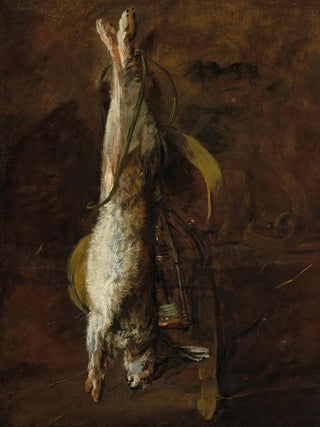Art print | A dead rabbit and a bag - Jean Siméon Chardin


View from behind

Frame (optional)
The work titled "Un lapin mort et une sacoche" by Jean Siméon Chardin, created in the 18th century, embodies the essence of the still life genre. Through this piece, Chardin invites us to contemplate the fleeting beauty of life and death, while revealing the subtleties of light and textures. The composition, both simple and powerful, evokes an atmosphere of reflection and serenity, transporting the viewer into a universe where every detail matters. The presence of the rabbit, a symbol of nature, juxtaposes the bag, an everyday object, thus creating a dialogue between the living and the inanimate, between the natural and the artificial.
Style and uniqueness of the work
Chardin stands out for his realistic approach and mastery of color nuances. In "Un lapin mort et une sacoche," he uses a palette of earthy tones to emphasize the materiality of the depicted objects. The rabbit's fur is rendered with remarkable precision, while the leather bag appears almost tangible. This meticulous attention to detail demonstrates his deep respect for nature and the simple things of daily life. The light, subtly diffused across the surfaces, creates an effect of depth and volume, inviting the viewer to immerse themselves in this tranquil scene. The composition, although static, exudes a particular dynamism, as if time has been suspended, offering a unique contemplative experience.
The artist and his influence
Jean Siméon Chardin, an emblematic figure of the 18th century, managed to mark his era with his innovative approach to painting. His work is rooted in the Rococo movement but is distinguished by a sensitivity unique to him. Chardin transcended the conventions of his time by highlighting ordinary subjects, thus celebrating the beauty of everyday life. His influence extends far beyond his era, inspiring generations of artists, notably the Impressionists who saw in him a pioneer. His ability to capture the soul of objects and confer upon them an almost spiritual dimension paved the way for new artistic explorations. Through his technique

Matte finish

View from behind

Frame (optional)
The work titled "Un lapin mort et une sacoche" by Jean Siméon Chardin, created in the 18th century, embodies the essence of the still life genre. Through this piece, Chardin invites us to contemplate the fleeting beauty of life and death, while revealing the subtleties of light and textures. The composition, both simple and powerful, evokes an atmosphere of reflection and serenity, transporting the viewer into a universe where every detail matters. The presence of the rabbit, a symbol of nature, juxtaposes the bag, an everyday object, thus creating a dialogue between the living and the inanimate, between the natural and the artificial.
Style and uniqueness of the work
Chardin stands out for his realistic approach and mastery of color nuances. In "Un lapin mort et une sacoche," he uses a palette of earthy tones to emphasize the materiality of the depicted objects. The rabbit's fur is rendered with remarkable precision, while the leather bag appears almost tangible. This meticulous attention to detail demonstrates his deep respect for nature and the simple things of daily life. The light, subtly diffused across the surfaces, creates an effect of depth and volume, inviting the viewer to immerse themselves in this tranquil scene. The composition, although static, exudes a particular dynamism, as if time has been suspended, offering a unique contemplative experience.
The artist and his influence
Jean Siméon Chardin, an emblematic figure of the 18th century, managed to mark his era with his innovative approach to painting. His work is rooted in the Rococo movement but is distinguished by a sensitivity unique to him. Chardin transcended the conventions of his time by highlighting ordinary subjects, thus celebrating the beauty of everyday life. His influence extends far beyond his era, inspiring generations of artists, notably the Impressionists who saw in him a pioneer. His ability to capture the soul of objects and confer upon them an almost spiritual dimension paved the way for new artistic explorations. Through his technique






